<> Euploea mulciber (Cramer, 1777) <>
the Striped Blue Crow ผีเสื้อจรกาเมียลาย
Click on any photo to see all photos full size in Lightbox
Additions and corrections to the information provided on this page is always welcome. Please use the Contact form.
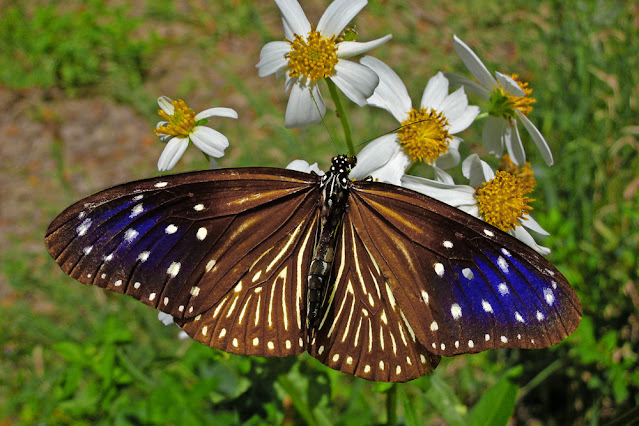
Photo taken at Doi Suthep-Pui National Park, Chiang Mai, Thailand ♀ 450m a.s.l.

Euploea mulciber is a common species that is found throughout the region, helped by the fact that it is polyphagous with many host plant species, especially a wide variety of fig trees. It is sexually dimorphic and the sexes, although similar in colour, look quite different with the common name deriving from the appearance of the female. It is a large butterfly with a slow deliberate flight.
Unusually, the female of this species is seen almost as often as the male. Both sexes are regular mud puddlers and both visit flowers for nectar. Euploea mulciber is basically a forest dweller but often ventures into urban areas. It is multivoltine and with a relatively short life cycle produces many broods per annum.
Synonyms and previously used names: Papilio mulciber, Amaura diocletia, Danais claudia, Trepsichrois linnaei, Papilio claudius, Euploea megilla, Trepsichrois mulcibra
Taxonomy: Animalia - Arthropoda - Insecta - Lepidoptera - Nymphalidae - Danainae - Euploea - mulciber
Regional subspecies: E.m.barsine (Taiwan), E.m.basilissa (Indonesia), E.m.dufresne (Philippines), E.m.mulciber (India, Nepal, Myanmar, Thailand, Cambodia, Vietnam, China, W.Malaysia, Singapore), E.m.portia (E.Malaysia, Indonesia), E.m.semperi (Philippines), E.m.vandeventeri (Indonesia), E.m.visaya (Philippines). There are a number of other subspecies recorded amongst the islands of Indonesia and the Philippines.
Regional Distribution: India, Nepal, Bhutan, Bangladesh, Myanmar, Thailand, Laos, Cambodia, Vietnam, China, Taiwan, Malaysia, Singapore, Indonesia, Philippines
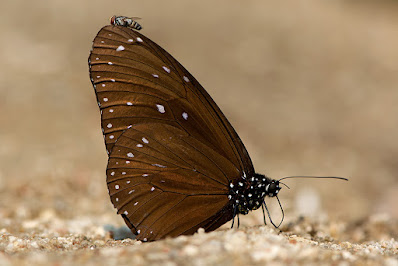 |
Doi Suthep-Pui National Park, Chiang Mai, Thailand ♂ 420m a.s.l. |
Habitat: Euploea mulciber is found in a wide range of habitats including primary and secondary forest, mangroves, wastelands, urban parks, and city gardens. In Nepal they have been recorded at elevations up to 3500m a.s.l.
Flight time: all year depending on location Wingspan: 80-90mm
Life History: egg 3-4 days instar 1 2-3 days instar 2 1-2 days instar 3 1-2 days instar 4 1-2 days instar 5 3-4 days pupa 7-8 days Total egg to adult 20-27 days. All times are approximate.
Larval Hosts: Calotropis gigantea, Cryptolepis sinensis, Gymnanthera oblonga, Gymnema sylvestre, Ichnocarpus frutescens, Marsdenia tinctoria, Nerium oleander, Oxystelma esculentum, Parsonsia alboflavescens, Pottsia laxiflora, Toxocarpus villosus, Toxocarpus wightianus, Trachelospermum jasminoides, Urceola rosea (Apocynaceae), Heliotropium indicum (Boraginaceae), Ficus altissima, Ficus ampelos, Ficus benjamina, Ficus chartacea, Ficus drupacea, Ficus fistulosa, Ficus globosa, Ficus grossularioides, Ficus heteropleura, Ficus lamponga, Ficus microcarpa, Ficus nervosa, Ficus pumila, Ficus punctata, Ficus racemosa, Ficus retusa, Ficus erecta, Ficus formosana, Ficus sarmentosa, Ficus semicordata, Ficus vasculosa, Ficus virgata (Moraceae). Actual host plant used depends upon location and availabilty of plant species.
Adult Food Sources: Nectar - Duranta erecta, Lantana camara (Verbenaceae), Heliotropium indicum (Boraginaceae), Premna serratifolia (Lamiaceae), Adenostemma lavenia, Ageratum conyzoides, Austroeupatorium inulifolium, Bidens alba, Bidens pilosa, Chromolaena odorata, Clibadium surinamense, Cosmos caudatus (Asteraceae), Syzygium sp. (Myrtaceae), Bougainvillea sp. (Nyctaginaceae), Ixora coccinea (Rubiaceae), Melastoma malabathricum (Melastomataceae), Crotalaria pallida (Fabaceae), Alnus nepalensis (Betulaceae), Cyananthus incanus (Campanulaceae), Rhododendron falconeri (Ericaceae), Swertia chirayita (Gentianaceae), Magnolia campbellii (Magnoliaceae), Coelogyne corymbosa (Orchidaceae), Wendlandia coriacea (Rubiaceae), Hedychium ellipticum (Zingiberaceae). Other - mud puddling, over-ripe fruit, carrion, animal dung & urine.
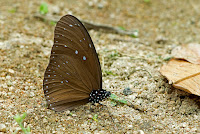 |
| Doi Suthep-Pui National Park, Chiang Mai, Thailand ♂ |
 |
| Doi Suthep-Pui National Park, Chiang Mai, Thailand ♂ |
 |
| Doi Suthep-Pui National Park, Chiang Mai, Thailand ♀ |
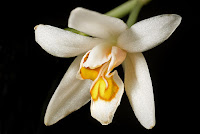 |
| Coelogyne corymbosa, a nectar source |
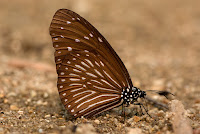 |
| Doi Suthep-Pui National Park, Chiang Mai, Thailand ♀ |
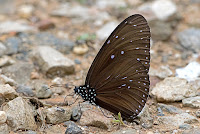 |
| Chiang Dao Nature Sanctuary, Chiang Mai, Thailand ♂ |
 |
| Lamnamkok National Park, Chiang Rai, Thailand ♂ |
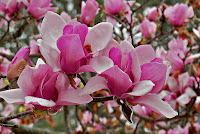 |
| Magnolia campbellii, another nectar source |
 |
| Doi Suthep-Pui National Park, Chiang Mai, Thailand ♂ |
 |
| Doi Suthep-Pui National Park, Chiang Mai, Thailand ♂ |
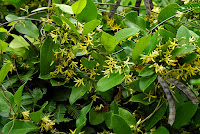 |
| Toxocarpus wightianus, a larva host |
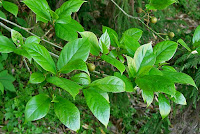 |
| Ficus erecta, another larva host |
Links to other pages in this series for species in the same subfamily
Euploea mulciber
Tirumala limniace
